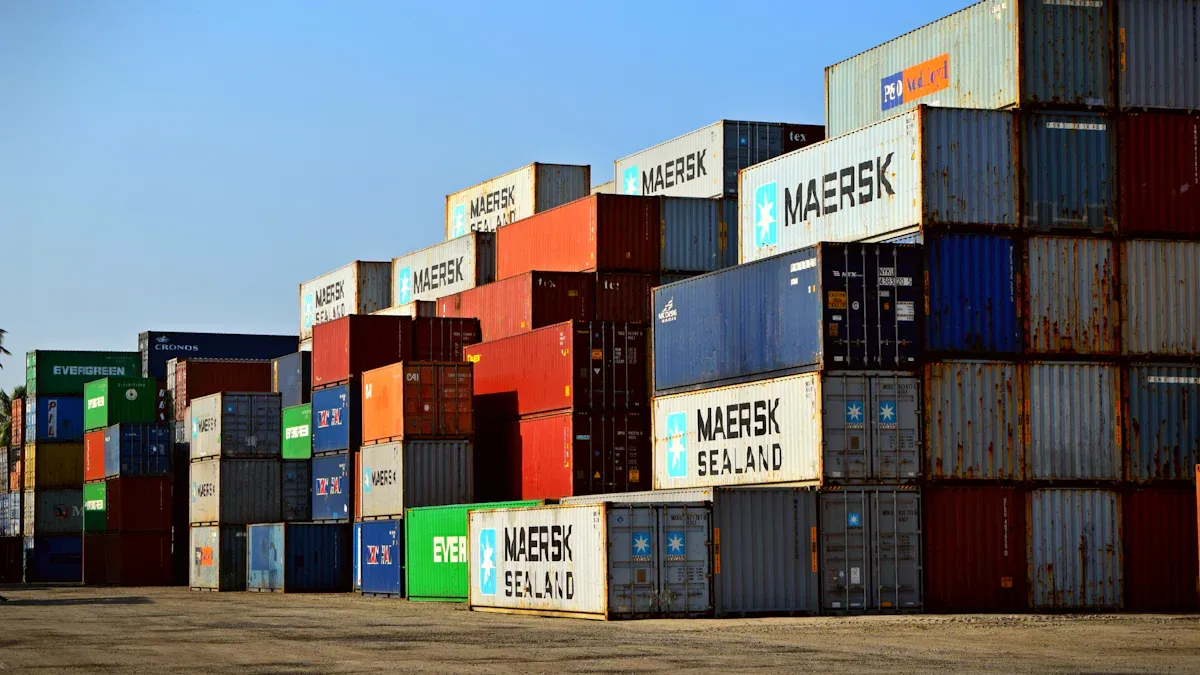Proven Methods to Optimize Logistics Costs in 2025

In 2025, cutting logistics costs will be very important. Businesses need this to stay profitable and competitive. Delivery costs will rise, with last-mile delivery making up 41%. To succeed, use better route planning and digital tools. These will improve efficiency and lower extra costs.
Key Takeaways
Knowing logistics costs is very important. Look at transport, storage, and stock to find ways to save money.
Using tools like AI and live data can cut costs a lot. Use smart routes and machines to work faster and better.
Check shipping bills often and track key numbers to spot extra costs and make logistics work smoother.
Understanding Logistics Costs
Knowing logistics costs is key to staying competitive in 2025. These costs include many parts that affect profits. By spotting these parts, you can find ways to save money and work better.
Key Parts of Logistics Costs
Logistics costs have several main parts that affect supply chains. These are:
Transportation Costs: Money spent on freight, fuel, and handling.
Warehousing Fees: Payments for storage, utilities, and safety.
Inventory Carrying Costs: Money tied in stock, like insurance and wear.
Packaging and Handling: Costs for packing materials and labor.
Reverse Logistics Costs: Money spent on returns and broken items.
A McKinsey report says smart supply chain plans can cut costs by 15%. Using advanced tools can also lower stock levels by 20-50% and make supply chains 10-15% better.
Big Expense Areas: Transportation, Warehousing, and Inventory
Transportation, warehousing, and inventory are the biggest cost areas. Each needs good management to avoid high expenses.
Cost Type | Details |
|---|---|
Transportation Costs | Includes fuel, repairs, tolls, and driver pay. |
Warehousing Costs | Covers rent, power, tools, and worker wages. |
Inventory Management Costs | Includes storage, insurance, and handling fees. |
Transportation is often the priciest part of logistics. Better routes and combining shipments can save money. Warehousing costs depend on space and worker efficiency. Tools like JUSDA's JusLink give live inventory updates. This helps cut stock costs and improve supply chains.
By focusing on these big costs, you can save money and work smarter.
Factors Affecting Logistics Costs
Problems in Operations and Their Effects
Bad operations make logistics more expensive. Poor route planning causes longer trips, more fuel use, and higher repair costs. Tools using AI can plan better routes. This saves time and money. Automating logistics also makes work faster and cheaper. Businesses using AI tools often save money by avoiding delays and using resources better.
Example | How It Helps |
|---|---|
AI plans better routes, saving time and money. | Cuts delivery costs by improving routes. |
Good route planning lowers repair and fuel costs. | Saves money by reducing travel distances. |
AI automation makes logistics faster and smoother. | Reduces costs by fixing slow processes. |
Complicated Supply Chains and Market Changes
Complex supply chains and changing markets raise costs. Hard-to-manage networks need more coordination, which costs more. Location matters too. Being close to customers lowers storage and transport costs. Market changes make logistics harder, with demand and transport prices going up and down. Companies often need extra stock and faster shipping. Studies show fixing supply chains can cut costs by 15-30% and speed up deliveries by 33%.
Fact | What It Means |
|---|---|
Costs drop 15-30% with better supply chains. | Shows savings from fixing supply chain issues. |
75% of companies face big problems. | Shows how market changes affect logistics. |
Deliveries are 33% faster with good management. | Shows how fixing supply chains helps efficiency. |
Rules and Compliance Costs
Following rules adds to logistics costs. Businesses deal with many rules from different governments, especially in places like India. Laws like the Carriage by Road Act and Warehousing Act cost a lot, especially for small businesses. No central info system makes following rules harder. Companies must handle many rules. Government plans like the National Logistics Policy aim to make this easier. They want to lower costs and improve logistics.
Small businesses struggle with many registrations and rules.
Government plans focus on tech and better systems to help.
Proven Strategies for Cutting Logistics Costs
Using Technology to Save Money
Technology helps lower logistics costs in big ways. Businesses save money by using tools like AI, IoT, and blockchain. For example, UPS and DHL show how tech works. UPS's ORION system saves miles, cutting fuel use and costs. DHL's SmarTrucking uses IoT and AI to cut delivery times by 30% and improve on-time rates to 95%.
Automation also makes warehouses work better. It lowers labor costs and boosts efficiency. Tools like JUSDA's JusLink track inventory live. This helps make smarter choices and avoid hidden costs. Using advanced tech can simplify work and save money.
Saving Money on Transportation
Transportation is one of the biggest costs in logistics. Better routes help save money. Companies like Amazon and Walmart use smart routing and transport methods. Amazon uses real-time data to cut fuel use and miles. Walmart combines trucks, trains, and ships to save money and deliver on time.
Combining shipments is another way to save. Sending multiple orders together cuts costs and improves service. Focusing on transport management and route planning can lower costs and improve quality.
Making Warehouses More Efficient with JUSDA
Good warehouse management is key to saving money. JUSDA's JusLink platform improves control and visibility. Tools like RFID and WMS make operations more accurate and cheaper. Services like VMI and cross-border logistics make supply chains smoother.
JUSDA helps industries like electronics and cars save money. With over 2.5 million square meters of warehouse space, JUSDA offers tools to boost automation and cut costs.
Getting Better Deals from Suppliers
Talking with suppliers can save a lot of money. Compare supplier prices, quality, and services to industry standards. Find areas to improve and negotiate better deals. Use data to make smart choices during talks.
For big contracts, data shows where costs are too high. This helps in getting better deals. Knowing how suppliers price things and building long-term partnerships can save money.
Going Green to Save Over Time
Being eco-friendly saves money too. Using energy-saving vehicles and better packaging cuts costs. Companies that go green save on fuel and waste costs.
For example, green transport and cutting carbon footprints save money and improve brand image. Eco-friendly practices match global trends and rules, keeping businesses competitive.
Continuous Evaluation for Logistics Cost Optimization

Checking your logistics often helps keep costs low and work smooth. Using methods like freight checks, tracking KPIs, and smart tools can find problems, cut costs, and save money over time.
Conducting Freight Audits and Cost Analyses
Freight checks and cost reviews help find hidden spending in logistics. Looking at freight bills regularly shows mistakes, improves carrier work, and keeps contracts on track.
Key Benefits of Freight Audits:
Fix billing mistakes to save 5%-10% each year.
Catch errors in 25% of freight bills to stop overpaying.
Use data to make carriers work better.
Follow contract rules to avoid extra charges.
See and control where your logistics money goes.
Freight audits make costs more accurate and keep finances clear, saving a lot of money.
Monitoring KPIs and Performance Metrics
Watching KPIs helps check how well logistics plans work. Focus on numbers that lower costs and improve operations.
What It Shows | |
|---|---|
Customer Backorder Rate | How often orders can't be filled, hurting customer happiness. |
Inventory Accuracy | How close inventory records match the real stock. |
Trailer Utilization Rate | How well trailers are packed, cutting transport costs. |
Warehousing Costs | Money spent on warehouse work, showing efficiency. |
Delivery Time | How fast orders arrive, keeping customers loyal. |
Tracking these KPIs shows where to improve and helps meet cost-saving goals.
Using Advanced Analytics for Strategic Decision-Making
Smart tools help make better choices to lower logistics costs. Predictive tools guess future needs, letting you plan ahead. Real-time tools give quick updates to fix problems fast.
Tool | How It Helps |
|---|---|
Predictive Analysis | Predicts future trends to adjust plans early. |
Real-time Analytics | Gives instant updates to solve problems quickly. |
Cost Efficiency | Finds ways to spend less by studying costs closely. |
Risk Management | Spots risks early and helps plan for smooth operations. |
Using these tools improves decisions, avoids risks, and saves money in logistics.

JUSDA Solutions
To provide you with professional solutions and quotations.
Cutting logistics costs is key to staying ahead in 2025. Using tools like predictive analytics and ERP systems can save money. For example:
GreenTech Supplies saved $40 per shipment by cutting transport costs 33%.
Crafty Creations lowered storage costs by improving how fast stock moves.
These ideas make deliveries faster and increase profits. Use these methods to succeed in changing logistics markets.
See Also
Understanding Supply Chain Cost Efficiency Through Economic Principles
Unlocking Logistics Savings: Expert Tips for Supply Chain Success
Five Leading Logistics Solutions to Explore in 2024
Best Practices for Successful Supply Chain Optimization Strategies
Discover Five Cutting-Edge Techniques for Supply Chain Optimization
